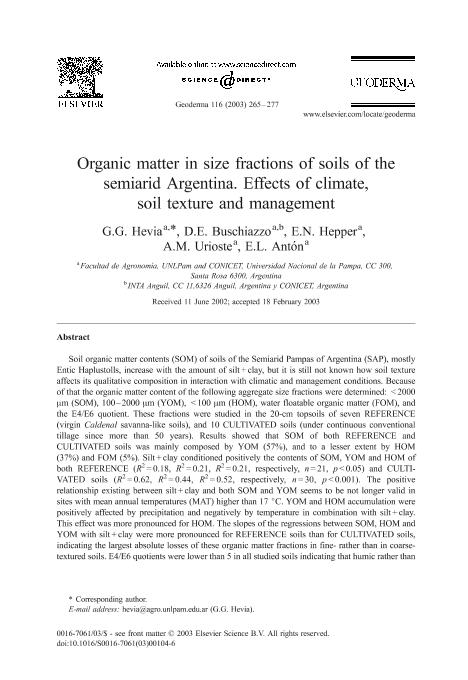Mostrar el registro sencillo del ítem
dc.contributor.author
Hevia, Graciela Gloria

dc.contributor.author
Buschiazzo, Daniel Eduardo

dc.contributor.author
Hepper, Estela Noemí

dc.contributor.author
Ana María, Urioste

dc.contributor.author
Antón, E. L.
dc.date.available
2019-08-16T18:52:54Z
dc.date.issued
2003-02
dc.identifier.citation
Hevia, Graciela Gloria; Buschiazzo, Daniel Eduardo; Hepper, Estela Noemí; Ana María, Urioste; Antón, E. L.; Organic matter in size fractions of soils of the semiarid Argentina. Effects of climate, soil texture and management; Elsevier Science; Geoderma; 116; 3-4; 2-2003; 265-277
dc.identifier.issn
0016-7061
dc.identifier.uri
http://hdl.handle.net/11336/81755
dc.description.abstract
Soil organic matter contents (SOM) of soils of the Semiarid Pampas of Argentina (SAP), mostly Entic Haplustolls, increase with the amount of silt+clay, but it is still not known how soil texture affects its qualitative composition in interaction with climatic and management conditions. Because of that the organic matter content of the following aggregate size fractions were determined: <2000 μm (SOM), 100-2000 μm (YOM), <100 μm (HOM), water floatable organic matter (FOM), and the E4/E6 quotient. These fractions were studied in the 20-cm topsoils of seven REFERENCE (virgin Caldenal savanna-like soils), and 10 CULTIVATED soils (under continuous conventional tillage since more than 50 years). Results showed that SOM of both REFERENCE and CULTIVATED soils was mainly composed by YOM (57%), and to a lesser extent by HOM (37%) and FOM (5%). Silt+clay conditioned positively the contents of SOM, YOM and HOM of both REFERENCE (R2=0.18, R2=0.21, R 2=0.21, respectively, n=21, p<0.05) and CULTIVATED soils (R 2=0.62, R2=0.44, R2=0.52, respectively, n=30, p<0.001). The positive relationship existing between silt+clay and both SOM and YOM seems to be not longer valid in sites with mean annual temperatures (MAT) higher than 17°C. YOM and HOM accumulation were positively affected by precipitation and negatively by temperature in combination with silt+clay. This effect was more pronounced for HOM. The slopes of the regressions between SOM, HOM and YOM with silt+clay were more pronounced for REFERENCE soils than for CULTIVATED soils, indicating the largest absolute losses of these organic matter fractions in fine- rather than in coarse-textured soils. E4/E6 quotients were lower than 5 in all studied soils indicating that humic rather than fulvic acids exist in the well humified organic fraction of the studied soils. Contents of FOM and E4/E6 values did not correlated with the climatic conditions nor with soil texture or management. Potential SOM losses can be larger in fine-textured soils (up to 54.3 Mg C ha-1) than in coarse-textured (up to 35.7 Mg C ha-1). Probable changes of soil texture by wind erosion will modify absolute contents of SOM, YOM and HOM, while modifications of temperature or rains regimes will affect HOM more.
dc.format
application/pdf
dc.language.iso
eng
dc.publisher
Elsevier Science

dc.rights
info:eu-repo/semantics/openAccess
dc.rights.uri
https://creativecommons.org/licenses/by-nc-sa/2.5/ar/
dc.subject
Climate
dc.subject
Cultivation
dc.subject
Organic Matter
dc.subject
Semiarid Regions
dc.subject
Size Fractions
dc.subject
Soil Texture
dc.subject.classification
Ciencias del Suelo

dc.subject.classification
Agricultura, Silvicultura y Pesca

dc.subject.classification
CIENCIAS AGRÍCOLAS

dc.title
Organic matter in size fractions of soils of the semiarid Argentina. Effects of climate, soil texture and management
dc.type
info:eu-repo/semantics/article
dc.type
info:ar-repo/semantics/artículo
dc.type
info:eu-repo/semantics/publishedVersion
dc.date.updated
2019-08-15T16:20:55Z
dc.journal.volume
116
dc.journal.number
3-4
dc.journal.pagination
265-277
dc.journal.pais
Países Bajos

dc.journal.ciudad
Amsterdam
dc.description.fil
Fil: Hevia, Graciela Gloria. Universidad Nacional de La Pampa. Facultad de Agronomía; Argentina
dc.description.fil
Fil: Buschiazzo, Daniel Eduardo. Instituto Nacional de Tecnología Agropecuaria. Centro Regional La Pampa-San Luis. Estación Experimental Agropecuaria Anguil; Argentina. Consejo Nacional de Investigaciones Científicas y Técnicas. Instituto de Ciencias de la Tierra y Ambientales de La Pampa. Universidad Nacional de La Pampa. Facultad de Ciencias Exactas y Naturales. Instituto de Ciencias de la Tierra y Ambientales de La Pampa; Argentina
dc.description.fil
Fil: Hepper, Estela Noemí. Universidad Nacional de La Pampa. Facultad de Agronomía; Argentina
dc.description.fil
Fil: Ana María, Urioste. Universidad Nacional de La Pampa. Facultad de Agronomía; Argentina
dc.description.fil
Fil: Antón, E. L.. Universidad Nacional de La Pampa. Facultad de Agronomía; Argentina
dc.journal.title
Geoderma

dc.relation.alternativeid
info:eu-repo/semantics/altIdentifier/doi/http://dx.doi.org/10.1016/S0016-7061(03)00104-6
dc.relation.alternativeid
info:eu-repo/semantics/altIdentifier/url/https://www.sciencedirect.com/science/article/pii/S0016706103001046
Archivos asociados
